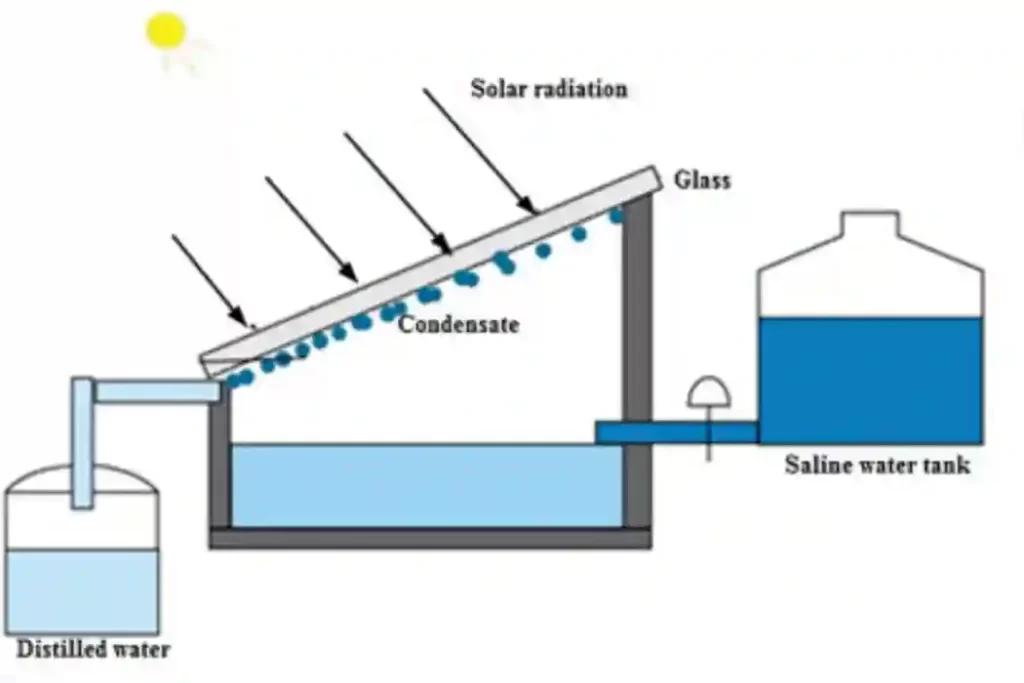In a world grappling with environmental challenges and water scarcity, solar distillation emerges as a promising green technology for obtaining clean and safe drinking water. Solar distillation is a simple and effective process that harnesses the sun’s energy to purify water, making it suitable for human consumption. Solar distillation, a green technology for clean water, serves as an eco-friendly source of knowledge for sustainable water purification. This article explores the concept of solar distillation, its benefits, and its potential applications as a sustainable solution to water scarcity.
What is Solar Distillation?
Solar distillation is a natural phenomenon that replicates the water cycle. It involves capturing solar energy to evaporate water from various sources, such as seawater, brackish water, or contaminated water, and then condensing the vapor to produce fresh water. This process mimics nature’s way of purifying water, ensuring that the distilled water is free from contaminants, including bacteria, viruses, and dissolved minerals.
The Solar Distillation Process
1. Solar Still Design
The heart of solar distillation is the solar still, which is designed to maximize the energy absorption from the sun while minimizing heat loss. Typically, a solar still consists of a shallow basin with a transparent cover, which allows sunlight to penetrate and heat the water.
2. Evaporation
As sunlight reaches the solar still, it warms the water in the basin. The heat causes the water to evaporate, leaving behind contaminants and impurities. The water vapor rises and accumulates on the inner surface of the transparent cover.
3. Condensation
The accumulated vapor condenses on the cool inner surface of the cover and transforms back into liquid water. This condensed water drips into a collection channel, where it is collected as fresh and clean water.

Benefits of Solar Distillation
1. Sustainability
Solar distillation is a sustainable and renewable technology since it solely relies on the sun’s energy, which is readily available in most parts of the world. It has no carbon emissions or negative environmental impacts, making it an eco-friendly solution.
2. Water Independence
One of the significant advantages of solar distillation is its ability to provide a localized water supply. It can be deployed in remote areas, arid regions, or places with limited access to freshwater sources, reducing dependence on centralized water distribution systems.
3. Low Maintenance
Solar distillation systems are relatively simple in design and require minimal maintenance. Once installed, they can operate with little human intervention, making them suitable for regions with limited technical expertise.
4. Reduction of Waterborne Diseases
Solar distillation effectively removes contaminants from water, including harmful pathogens, reducing the risk of waterborne diseases and improving public health.
5. Disaster Relief and Emergency Situations
In emergency situations, such as natural disasters or humanitarian crises, solar distillation can provide a reliable source of clean water, alleviating the immediate water needs of affected communities.
Applications of Solar Distillation
1. Desalination
Solar distillation is an effective method for desalinating seawater, providing a viable solution for regions facing water scarcity and relying on seawater for their freshwater needs.
2. Rural Water Supply
In rural areas with limited access to clean water sources, solar distillation can be an efficient and cost-effective solution to provide safe drinking water.
3. Agriculture and Irrigation
Solar distillation can also be utilized for irrigation purposes, especially in areas where water for agricultural use is scarce.
4. Sustainable Industries
Industries requiring clean water, such as pharmaceuticals and food processing, can benefit from solar distillation as a sustainable and eco-friendly water purification method.
Conclusion
Solar distillation stands as a promising green technology that holds the potential to address water scarcity and provide clean and safe drinking water. Its sustainable nature, coupled with its various applications, makes it an essential tool in the fight against water crises worldwide. Embracing solar distillation as a water purification method can contribute significantly to a greener, healthier, and water-secure future for all.
FAQs
Is solar distillation expensive to implement?
Solar distillation systems are generally cost-effective and can be tailored to suit various budgets. Additionally, the long-term savings in water costs and health benefits outweigh the initial investment.
Can solar distillation work in cloudy or overcast weather?
While solar distillation is most efficient in direct sunlight, it can still operate on cloudy or overcast days, albeit at a reduced efficiency.
Is the distilled water safe for drinking?
Yes, solar distillation effectively removes contaminants, making the distilled water safe for consumption.
How much water can a solar still produce in a day?
The water production capacity of a solar still depends on its size, design, and environmental conditions, but it can range from a few liters to several hundred liters per day.
Are there any downsides to solar distillation?
While solar distillation is a viable water purification method, its water production rate is relatively low compared to other technologies. It may not be suitable for high-demand scenarios.


